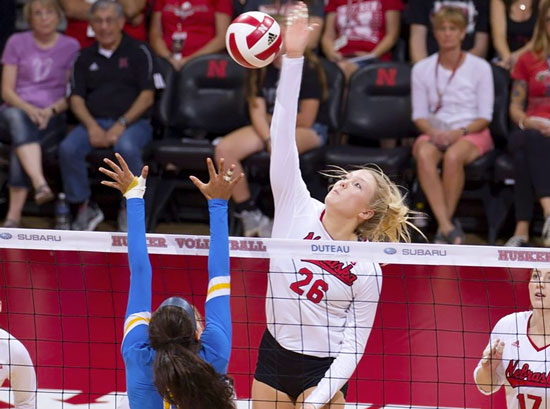Nov 2, 2018Husker Power Performance Index measures talent, development
Walk into the University of Nebraska volleyball locker room, and you’ll see a wall of portraits that celebrate the squad’s top-ranked players in the Husker Power Performance Index. It’s only fitting, as the index has played a significant role in the program’s four NCAA Division I national championships, one runner-up finish, and three other semifinal appearances since 2000.

“An important part of Husker Power is trying to be a great athlete. We take a lot of pride in that,” says John Cook, Head Volleyball Coach for Nebraska. “I am very thankful we can use the index for volleyball. It’s something really cool that we have, and it’s a big piece of our program.”
The brainchild of Assistant Athletic Director of Strength and Conditioning Boyd Epley, MEd, CSCS, the index has been in use at Nebraska since he came to the school in 1968. Although it was first employed primarily in football, a total of 24 Husker teams now embrace it.
“Coaches are basically looking for talent. The index helps us identify that talent,” says Epley. “It also provides a consistent way of measuring where athletes are in their development.”
Three tests are administered in the index: the standing vertical jump, the pro-agility run, and the 10-yard dash. Players are assessed twice yearly, always before and after a specified training period. “The tests measure different physical components but are factor-weighted,” Epley explains. “This means if an athlete’s scores are similar on all tests, they are balanced and don’t have any weakness in the areas being evaluated.”
Individual teams can also add a sport-specific fourth test. For example, basketball and volleyball both add the approach vertical jump. “It’s what the athletes do in a game, and it happens every third touch of the ball-they run to hit, or they run to jump and block,” Cook says.
“Test day is a big day,” he continues. “The players might get more nervous for that than they do matches. That tells you how serious it is.”
» ALSO SEE: Strength Coaches Roundtable: Analytics in training
The results are then entered into an algorithm developed by Epley; Mike Arthur, CSCS, RSCC*E, Director of Strength and Conditioning Performance Research for the Huskers; and Chris Eskridge, PhD, Professor in Nebraska’s School of Criminology and Criminal Justice. The formula takes into account world records, research, and more than 30 years of Husker testing data. “We were able to statistically determine which tests actually measure the qualities we are looking for,” says Epley. “The index has much more to do with how close you are to the world’s best than standard deviations or how far you are from the average.”

The algorithm determines how many points each student-athlete has achieved per test, using a scale of zero to 1,000. The points from all three assessments are then combined, producing one cumulative score. “One thousand points on any single test would be considered the best performance there ever was, but 500 points is what our athletes typically strive for,” Epley says. “A total of 1,500 is a big deal, and that’s pretty much where D-I scholarship athletes are.”
If a team adds an optional sport-specific test, the total goal changes accordingly. “Our athletes still aim for 500 points per test, so their target is 2,000 points,” Cook says. “Players have told me that when they reach the 2,000-point club, it’s a really meaningful achievement for them.”
Cook keeps his players on track with the index by having them set goals. “We have individual goals, which are very simple. Let’s say you scored 1,600 points in March. Maybe your goal is to get to 1,800 points in November,” he says. “Then, we’ll set a team goal by combining everyone’s scores. If we start at 25,000 points, we’ll try to get to 26,000.
“We had an All-American senior improve 400 points this year, so that was a really significant jump,” Cook continues. “We made a big deal about it by giving her our Lifter of the Year Award at our Red-White Game in front of 8,000 people.”
As coach of one of the highest-scoring Husker squads in the index each year, Cook believes the testing is far more than a motivational tool. “It’s not only a way to measure that our players are improving, it’s a way to evaluate whether our strength program is producing the results we think it is,” he says. “It also holds our players accountable. If someone’s index scores do not improve, then it’s pretty much on them.”
The index has made its way beyond Nebraska, as well. In 2006, Epley left the school for an opportunity with the NSCA, serving as the Director of Coaching Performance until 2011 and Senior Director of Coaching and Special Projects from 2011 to 2014 before returning to Nebraska in 2015. While with the NSCA, he introduced the performance index specifically for high school athletes, using the same testing format and scoring expectations he developed for the Huskers.
“A good high school score would be 400 per test,” Epley says. “But if an athlete can score 500 points on every test, they’re special and should be looked at as a D-I scholarship athlete.”
Whether it’s a college or high school athlete being evaluated, one thing remains the same with the Husker Power Performance Index-it will work to develop better athletes. “We all want to increase speed, power, and agility, and we know that putting on muscle is how you improve those things,” Epley says. “Once you figure out the best way to put on muscle, it improves your talent and index score, which means you’re going to be a better athlete.”



